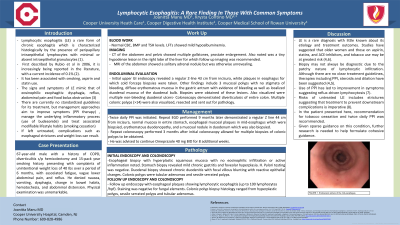Sunday Poster Session
Category: Esophagus
P0525 - Lymphocytic Esophagitis: A Rare Finding In Those With Common Symptoms
Sunday, October 27, 2024
3:30 PM - 7:00 PM ET
Location: Exhibit Hall E

Has Audio

Joanitta M. Manu, MD
Cooper University Hospital
Cherry Hill, NJ
Presenting Author(s)
Krysta Contino, MD1, Joanitta M. Manu, MD2
1Digestive Health Institute at Cooper University Hospital, Mount Laurel, NJ; 2Cooper University Hospital, Cherry Hill, NJ
Introduction: Chronic esophagitis is a common disease with multiple etiologies with treatment dependent on the underlying etiology. Lymphocytic esophagitis (LE), a rare variant first described in 2006, is being increasingly reported in the literature. Symptoms include reflux and dysphagia. A diagnosis of LE is made histologically with findings of increased intraepithelial lymphocytes with rare or no granulocytes and spongiosis.
Case Description/Methods: We present the case of a 67-year-old male with a history of COPD, diverticulitis s/p hemicolectomy, GERD, ventral hernia mesh repair and a 15 pack year smoking history who initially presented with 6 months of fatigue, unintentional weight loss and reflux. Extensive work-up including blood work, CT abdomen of chest, abdomen and pelvis, and MRI for adrenal hyperplasia were completed without a clear source of weight loss.
Colonoscopy revealed multiple numerous sessile serrated lesions and tubular adenomas. Initial endoscopy noted white patches in the middle third of the esophagus with histology showing hyperplastic mucosa. Follow up endoscopy and biopsy of esophageal plaques were consistent with lymphocytic esophagitis (up to 100 lymphocytes X40 hpf). Recommendation was for a proton pump inhibitor (PPI) twice daily with follow up endoscopy/histologic evaluation: however, at the time of surveillance endoscopy, he reported only intermittent compliance to recommended therapy. Distal and proximal esophageal biopsies at the time, showed unchanged and persistent lymphocytosis.
Discussion: LE is a rare diagnosis with little known about the etiology and treatment outcomes. Studies have suggested that older women and those on aspirin, statins, and ACE-inhibitors and tobacco use may be at greatest risk. Biopsy may not always be diagnostic due to the patchy nature of lymphocytic infiltration. Although no clear treatment guidelines, therapies including PPIs, steroids and dilation have been suggested. Often, use of PPIs have led to improvement if symptoms suggest reflux-driven lymphocytosis. Risks of untreated LE include strictures, suggesting that treatment to prevent downstream complications is imperative. In the patient presented here, recommendation for tobacco cessation and twice daily PPI was given. Given sparse guidance on this condition, further research is needed to help formulate cohesive guidance.
Disclosures:
Krysta Contino, MD1, Joanitta M. Manu, MD2. P0525 - Lymphocytic Esophagitis: A Rare Finding In Those With Common Symptoms, ACG 2024 Annual Scientific Meeting Abstracts. Philadelphia, PA: American College of Gastroenterology.
1Digestive Health Institute at Cooper University Hospital, Mount Laurel, NJ; 2Cooper University Hospital, Cherry Hill, NJ
Introduction: Chronic esophagitis is a common disease with multiple etiologies with treatment dependent on the underlying etiology. Lymphocytic esophagitis (LE), a rare variant first described in 2006, is being increasingly reported in the literature. Symptoms include reflux and dysphagia. A diagnosis of LE is made histologically with findings of increased intraepithelial lymphocytes with rare or no granulocytes and spongiosis.
Case Description/Methods: We present the case of a 67-year-old male with a history of COPD, diverticulitis s/p hemicolectomy, GERD, ventral hernia mesh repair and a 15 pack year smoking history who initially presented with 6 months of fatigue, unintentional weight loss and reflux. Extensive work-up including blood work, CT abdomen of chest, abdomen and pelvis, and MRI for adrenal hyperplasia were completed without a clear source of weight loss.
Colonoscopy revealed multiple numerous sessile serrated lesions and tubular adenomas. Initial endoscopy noted white patches in the middle third of the esophagus with histology showing hyperplastic mucosa. Follow up endoscopy and biopsy of esophageal plaques were consistent with lymphocytic esophagitis (up to 100 lymphocytes X40 hpf). Recommendation was for a proton pump inhibitor (PPI) twice daily with follow up endoscopy/histologic evaluation: however, at the time of surveillance endoscopy, he reported only intermittent compliance to recommended therapy. Distal and proximal esophageal biopsies at the time, showed unchanged and persistent lymphocytosis.
Discussion: LE is a rare diagnosis with little known about the etiology and treatment outcomes. Studies have suggested that older women and those on aspirin, statins, and ACE-inhibitors and tobacco use may be at greatest risk. Biopsy may not always be diagnostic due to the patchy nature of lymphocytic infiltration. Although no clear treatment guidelines, therapies including PPIs, steroids and dilation have been suggested. Often, use of PPIs have led to improvement if symptoms suggest reflux-driven lymphocytosis. Risks of untreated LE include strictures, suggesting that treatment to prevent downstream complications is imperative. In the patient presented here, recommendation for tobacco cessation and twice daily PPI was given. Given sparse guidance on this condition, further research is needed to help formulate cohesive guidance.
Disclosures:
Krysta Contino indicated no relevant financial relationships.
Joanitta Manu indicated no relevant financial relationships.
Krysta Contino, MD1, Joanitta M. Manu, MD2. P0525 - Lymphocytic Esophagitis: A Rare Finding In Those With Common Symptoms, ACG 2024 Annual Scientific Meeting Abstracts. Philadelphia, PA: American College of Gastroenterology.
